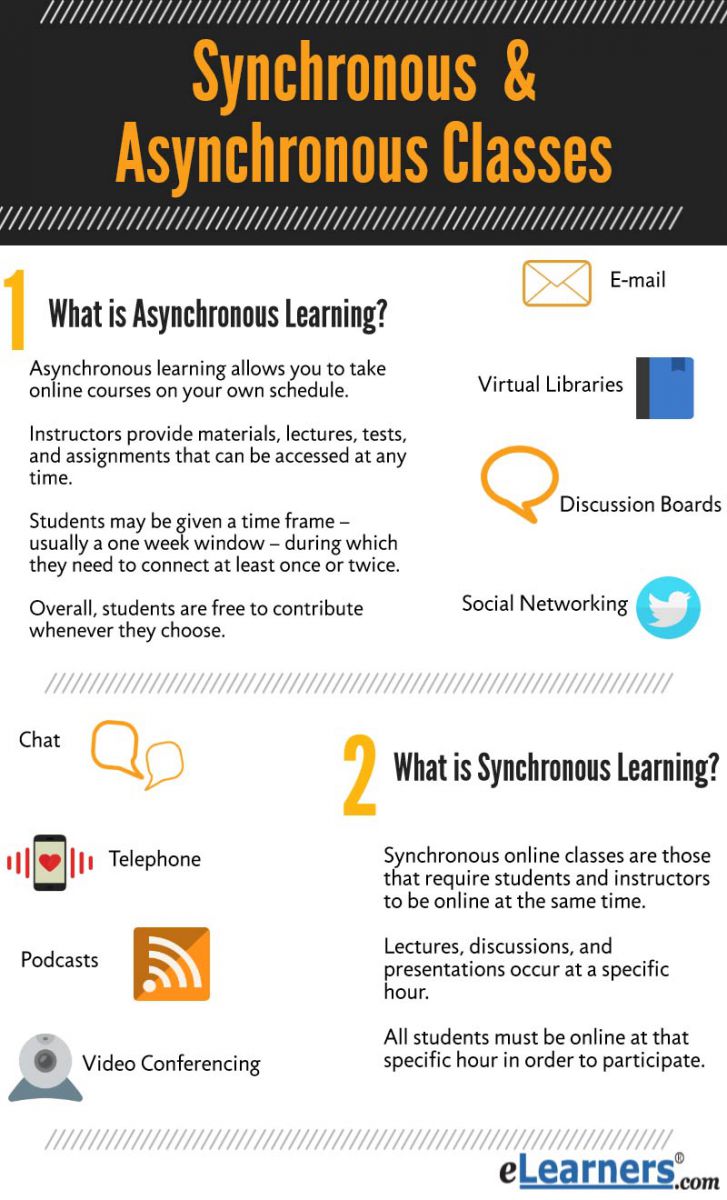In today's online learning environment we have two generally accepted methods of learning. The first being asynchronous facilitation, which was discussed in my earlier blog and the second being synchronous facilitation. This blog post will concentrate understanding synchronous learning and facilitation, benefits and challenges, and provide effective synchronous learning. Both methods have their own set of pros and cons, but the main thing to consider with both of these methods is how you as the facilitator can best reach your students.
 Synchronous learning is the use of synchronous computer conferencing as a Web-based communication system that supports real-time, many-to-many textual interactions. The interactions made possible through synchronous communication technologies allow participants to experience “same-time, same place” or “same-time, any place” collaboration. Such types of collaboration demonstrate the important traits of immediacy, fast planning, problem-solving, scheduling, and decision-making, which can be difficult to replicate in an asynchronous environment. Online conferencing similarly requires engagement to reach ideal educational objectives; synchronous online communication has the potential to engage students in knowledge sharing, mutual inspiration, interdependence, and active learning through conversation, argument, debate, and discussion among peers, experts, and teachers or moderators (S. Shi, C. Bonk, S.Tan, P. Mishra, 2008).
Synchronous learning is the use of synchronous computer conferencing as a Web-based communication system that supports real-time, many-to-many textual interactions. The interactions made possible through synchronous communication technologies allow participants to experience “same-time, same place” or “same-time, any place” collaboration. Such types of collaboration demonstrate the important traits of immediacy, fast planning, problem-solving, scheduling, and decision-making, which can be difficult to replicate in an asynchronous environment. Online conferencing similarly requires engagement to reach ideal educational objectives; synchronous online communication has the potential to engage students in knowledge sharing, mutual inspiration, interdependence, and active learning through conversation, argument, debate, and discussion among peers, experts, and teachers or moderators (S. Shi, C. Bonk, S.Tan, P. Mishra, 2008).
The role of a facilitator is expected to provide both direct and indirect instruction by interjecting comments, referring students to information resources, and organizing activities that allow the students to construct the content in their own minds and personal contexts. For instance, in this study, although the conferences were all structured - with pre-specified syllabi and agenda - the moderator played a critical role in ensuring that students were learning the material. This is clearly a difficult task, requiring the balancing of time pressure in monitoring and responding to a plethora of ideas and comments while capturing one’s thoughts about subject matter and ideas in fairly pithy and understandable postings. (S. Shi, C. Bonk, S.Tan, P. Mishra, 2008).
Benefits and Challenges of Synchronous Learning
Providing Effective Synchronous Learning requires the facilitator to develop effective learning opportunities using the technology and tools available. There are so many strategies to consider for providing effective synchronous learning. While researching synchronous learning I came across consistently mentioned strategies that would help facilitate effective synchronous learning.
- Consider your primary objective when creating the synchronous event/lesson/course plan.
- Clarify your online course expectations and objectives
- Develop a guide that learners can utilize to stay on track.
- Integrate group collaboration activities.
- Provide links to valuable resources and reference sites.
- Provide timely, relevant and actionable feedback.
- Encourage learners to offer feedback.
- Identify and employ the best online tools for interaction.
- Make a presentation available online after the synchronous event/lesson/course takes place.
- Check-up activity
- Create a Student-Centered Environment
Things to avoid in your synchronous learning environment:
- Don't assume your students have everything under control.
- Not knowing your audience
- Cut the unnecessary information.
- Not asking questions.
- Not checking in (learned this one myself).
- Not having a plan
- Being confused about the copyright.
- Inadequate assessment.
- Not enjoying the adventure you have created.
eLearners.com. (2017). Synchronous vs. Asynchronous Classes. [online] Available at: https://www.elearners.com/education-resources/degrees-and-programs/synchronous-vs-asynchronous-classes/ [Accessed 24 Apr. 2017].
eLearning Industry. (2017). 8 Tips To Create an Effective Synchronous eLearning Strategy - eLearning Industry. [online] Available at: https://elearningindustry.com/8-tips-create-effective-synchronous-elearning-strategy [Accessed 25 Apr. 2017].
Hanover Research. (2017). Delivery and Differentiation in Online Education: The Emergence of Synchronous Online Learning - Hanover Research. [online] Available at: http://www.hanoverresearch.com/2014/09/17/delivery-and-differentiation-in-online-education-the-emergence-of-synchronous-online-learning/ [Accessed 25 Apr. 2017].
http://www.onlinecollege.org, O. (2017). Avoid These 10 Common Mistakes in Online Learning - OnlineCollege.org. [online] OnlineCollege.org. Available at: http://www.onlinecollege.org/2011/06/29/avoid-these-10-common-mistakes-in-online-learning/ [Accessed 25 Apr. 2017].
Kathleen Poll, M. B. A., MAT, M., & Sherrie Weller, M. F. A. (2014). Six Instructional Best Practices for Online Engagement and Retention.
Marjanovic, O. (1999). Learning and teaching in a synchronous collaborative environment. Journal of Computer Assisted Learning, 15(2), 129-138.
McBrien, J. L., Cheng, R., & Jones, P. (2009). Virtual spaces: Employing a synchronous online classroom to facilitate student engagement in online learning. The International Review of Research in Open and Distributed Learning, 10(3).
Shi, S., Bonk, C., Tan, S., & Mishra, P. (2008). Getting in sync with synchronous: The dynamics of synchronous facilitation in online discussions. International Journal of Instructional Technology and Distance Learning, 5(5), 3-28.



No comments:
Post a Comment